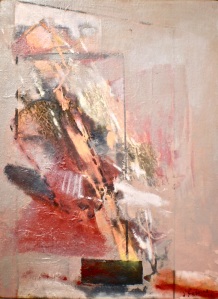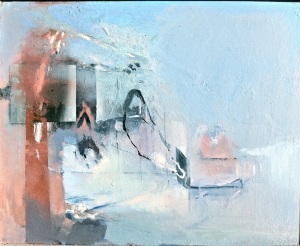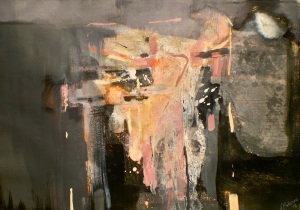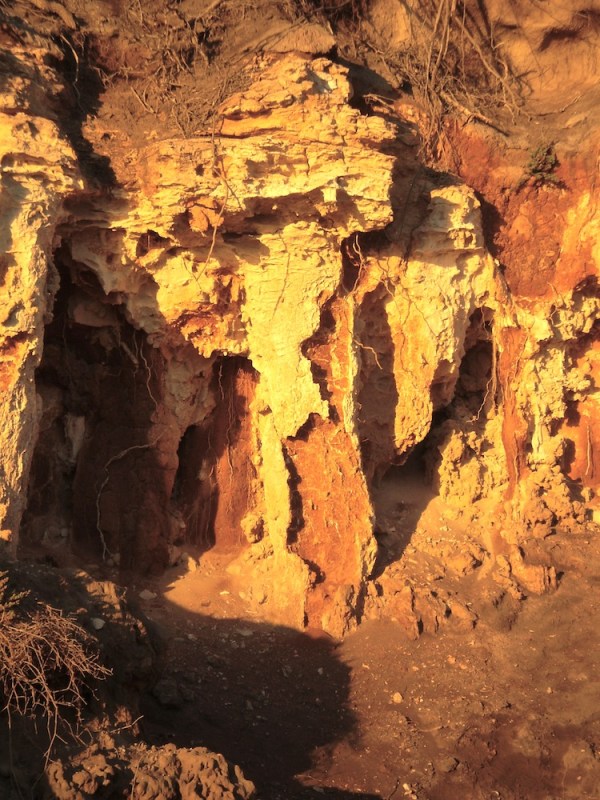- I placed a slide show on my Home Page consisting of several paintings from a series I titled Begin with Sand Silt and Water, 2012 – 2013. They were inspired by a feeling that many experience in the Australian outback. Although this continent lacks high mountain ranges and deep canyons and is in comparison quite flat it does have very ancient rocks formation, fossils and places worn to skeletal rock. Flimsy and fragile soil covering however reveals the underlying clues to the earth’s history.
The paintings produced after traveling, exploring, observing, sketching, photographing and taking frottage from rock surfaces develop as a result of these preliminaries. The locations depicted in the paintings are at Lake Mungo in New South Wales, Brachina Gorge in the Flinders Ranges, South Australia and close to home at Point Roadknight.
My overwhelming feelings are a mixture of wonder and curiosity about evolution of ancient reefs and seabeds, once in shallow seas 550 million years ago, into the Flinders Ranges. Paintings with titles termed “Golden Spike” refer to a landmark also in this area where fossils discovered as imprints on the sea floor reveal ancient jelly fish-like creatures. These Ediacaran fossils evolutionary significance as bilateral asexual organisms was their capacity to move, for example Sprigina and Dickensonia. In 2007 Dr Mary Droser discovered a coral-like creature resembling a worm that evolved the capacity to reproduce sexually.

The painting titled Remnant Lake Mungo, 2013 was created from feelings about timelessness and human insignificance in the desert, stripped bare under a huge almost overbearing sky. A long drive through dust-covered pot holes, corrugations and avoiding roadkill my fellow traveler and I approached Lake Mungo. The vista before us consisted of a dried lake bed, a clay pan and large dunes called ‘the Walls of China’. Briefly, pre-50,000 years ago the red soil of the lunettes rimming Mungo is termed the Gol Gol unit. 50,000 years ago white quartz sand blown onto the lunettes formed the Mungo Unit. As an overflow and part of the Willandra creek system water was plentiful and vegetation grew on the lunettes. 30,000 – 15,000 years ago clay pellets formed on the exposed mud flats. Sand and clay pellets blew onto the lunettes, forming the Zanci unit. 15,000 years ago to the present Mungo dried, more clay pellets built the lunettes, water erosion created deep gullies and wind-blown sand formed large mobile dunes and salt concentrated clay formed a black coating of erosion resistant algal crust.
Archaeologists discovered Mungo Woman and later Mungo Man thought at least 40,000 years old as well as stone artifacts, middens and fossilised footprints.

Point Roadknight just off the Great Ocean Road out of Anglesea is a land mark where erosion reveals aspects of geology in the form of what appears vertical fossilised tree roots that resemble columns in an ancient ruin. Have roots penetrated the above layer that may be an ancient sea bed made porous and through which seeped mineralised and calcified rainwater? The ‘columns’ appear anchored to hard rock formed by an ancient pyroclastic flow from hinterland volcanoes.
Others have various descriptions of this place such as ‘sinister’ and ‘threatening’ but for me it is a home to hooded plovers, a gray heron as well as my ‘observatory’. Colour, pattern, tonal contrast and texture in sky, rock, sand and water are sources of endless fascination.


You must be logged in to post a comment.